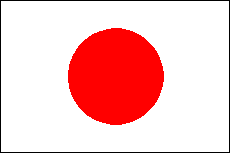Japan

Government: Constitutional Monarchy
Ruler: Emperor Meiji
Population: 55,000,000
In 1853, Japan was a isolated feudalistic society run by militaristic baron lords known as Samurai. These lords in turn served the Tokugawan Shogun. Unfortuantely for the Shogun, Japan of this time was beset by great internal and expernal pressures. From without, the various European colonial empires were pressuring Japan to open its borders to trade, usually hobbled by unfair tariffs and trade restrictions. Furthermore, Japan saw the advantages of an industrialized society, and the power it granted a nation. Finally, Japan had the poor example of China (who resisted colonial influence and paid dearly for it) to follow.
In 1867, the Shogun voulantarily stepped down to give power to the ancient Meiji line of royalty. A new government was seen as the best way to adapt to both dealings with European powers and the social changes of industrialization. Along withthis change came with a revival of the ancient Shinto religion (and Emperor worship), and a slow, methododical westernization plan.
Japan's views on Europe spurred Japan's industrial revolution. The country seeked to take advantages of railroads, telegraphs, and electricity. The Japanese used their forced relations with Europe to rapidly advance their technology and social systems. Europeans and American experts were brought in to build railroads, telegraphs, battleships, and schools. Like in Europe, a middle class of merchants, financiers, and manufacturers grew. This rise to power of the middle class nailed the lid on the last remnants of the old shogunate (who still had preferential powers from the government). In 1871 the Japanese government traded all of the shoguns special priveledges for government bonds.
One of the signs of this Westernization was the Rokumeikan (Hall of the Baying Stag). This building was erected in the 1880's to act as a pleasure palace where Western visitors were often entertained. Often a subject for public dissapproval, the Rokumeikan was the sight of many parties and much shmoozing and contributed greatly to international relations.
In 1881, a new system of law (based on Napoleonic code) was put into effect. In 1889, a constitution was ratified.
Japanese Careers
Samurai- Soc 5+
The Samurai were the militaristic lords of the Tokugawan shogunate. The Samurai class had been abolished in 1868 and were technically not found in Victorian age Japan. However, for those who really must play one, there could be an old Samurai left, or a decendant of one who has trained in secret.
Close Combat (pole or edged) 2, Eloquence 1, Bargaining 1, Riding (horse) 1, Leadership 2
Ninja- Soc 2-, Agl 4+
The Ninja are the famous warriors of the night. Due to the rigor of the ninja lifestyle, this counts as both careers.
Close Combat (edged) 3, Fisticuffs 2, Marksmanship (bow) 2, Throwing 1, Stealth 2, Wilderness Travel (Mountaineering) 2, Tracking 1, Theatrics 2
Geisha- female only, Cha 3+
The Geisha were professional entertainers in Japanese society. They were trained from childhood the arts of entertainment, conversation, poetry and dance. No party or gathering would be considered chic without them.
Stealth 1, Observation 1, Eloquence 2, Theatrics 2, Linguistics 1

Space 1889 is a registered trademark of Frank Chadwick.